How to make a warm floor under linoleum on a concrete floor: detailed instructions
Having set the task of arranging a warm floor under linoleum on a concrete floor, it is necessary to solve a difficult problem. Although linoleum in the construction market is presented in a large assortment, not everything that is offered can withstand temperature loads. With the technology of the device and the choice of materials it is worthwhile to understand. Is it true?
We will talk about how a floor heating system is constructed on a concrete base with the subsequent laying of linoleum. Our proposed article sets out in detail all the stages of construction: from the choice of materials to finishing finishing works. Popular device options are described.
The content of the article:
The secrets of the device underfloor heating under linoleum on concrete
Despite its great popularity, this material is hardly the best option for finishing coatings on a warm floor. Good thermal insulation properties, changes in shape and color under the influence of high temperature are not all of its disadvantages. The probability of release of harmful substances during heating is the main disadvantage of this flooring.
However, if you do not want to see anything other than linoleum on the floor, you can lay a warm floor under it, but not all types. The most suitable types of underfloor heating in this case are water and electric, which include infrared and cable views.
Mandatory conditions - installation in accordance with all the rules and strict adherence to the temperature regime. There are separate requirements for a concrete base. It must be prepared so that there are no differences in height. It is considered acceptable if on an area of 2 m² the difference in irregularities does not exceed 0.2 cm.
The base requires thorough cleaning, followed by the application of a primer and a waterproofing layer. To balance the expansion that occurs during the work of the floor, the walls are lowered around the perimeter with a compensation tape made of foamed polyethylene.
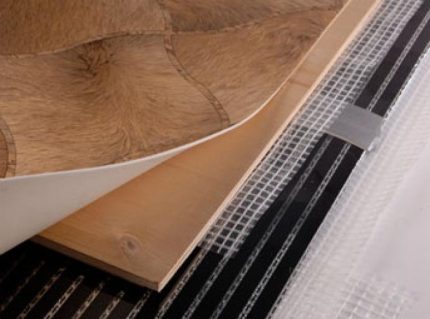
Which linoleum to choose?
Linoleum, present on the market, despite the visual similarity, differs in different parameters. It may have a different thickness, composition, structure, and the hardening base, if present, may differ in type.
When choosing linoleum, you need to correctly use the information encrypted in the markings affixed by the manufacturer. It encoded information about the composition of this type of coating, the possibility of heating, the maximum allowable temperature.
You should immediately remove from your list material based on glyphthalic polymer, i.e. alkyd linoleum. It is a low-heat-conducting coating, and over time changes its size. For the installation of underfloor heating, these properties are a big minus.
An unsuitable option is coloxylin linoleum based on nitrocellulose, which is highly combustible. Although the composition of such linoleum contains flame retardant acid, which slightly reduces the fire hazard of the material, it is not advised to arrange underfloor heating under it.
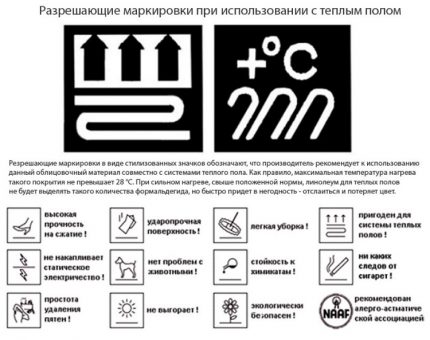
Rubber linoleum relin should also not be considered. In addition to being a good heat insulator, when heated from below, the material can change the structure. This will quickly lead to its destruction.
Polyvinylchloride linoleum with good strength and hygienic characteristics, is suitable for a warm floor more than other types. A more expensive option is natural linoleum (marmolium), created on the basis of safe components.
It contains jute fabric, natural dyes and other natural ingredients. The main rule: PVC linoleum can be heated only up to 30⁰, and natural - up to 27⁰ maximum.
When choosing PVC linoleum for finishing the underfloor heating, it is better to consider not its domestic appearance, but commercial or semi-commercial, as more durable. A heat-insulating base for this purpose is not needed, it will only reduce the effectiveness of the system.
The material is more suitable, either without a base or with a very thin fabric substrate. At first, vinyl linoleum paired with a heating cable may produce an unpleasant odor, but then it will disappear.
Concrete floor device
Immediately solve problems associated with installation of the "Warm floor" system on a concrete base, and you can choose the appropriate type of linoleum when the subfloor already exists. If instead of it there is only an old rotten wooden base or just soil, you need to deal with the device of the concrete floor itself.
The process consists of several stages:
- disassembling the old floor, if any;
- leveling the base;
- cushion devices;
- arrangement of a warming layer;
- preparation and pouring concrete mortar.
Leveling the soil is carried out using a shovel. Then they begin to create a pillow. For this, crushed stone or small pieces of brick, broken slate are poured to a height of about 50 mm. All this is a little rammed.
The perimeter of the room is closed with sheet foam having a thickness of 20 - 50 mm. It will serve as a formwork, and at the same time balance the thermal expansion of the concrete base. Pure sand is poured onto this layer - 10 centimeters.
Then follows the laying of the second type of insulation. Most suitable for this extruded polystyrene foam, preferably Penoplex brand, which is produced in the form of rigid plates with a thickness of at least 50 mm.

On the sheets, the manufacturer provided for a locking connection, so when they are laid, there are no gaps. During installation, you must monitor the horizontal with the help of a level. Waterproofing is not needed here, because The material is extremely resistant to moisture.
The next step is the preparation of the solution. The optimal ratio of components is 1 part of cement, twice as much sand and three times as much screening. As a result, the solution should not be fluid, but not excessively thick.
In order not to heavily load the floor, light fillers and levelers are introduced into the concrete solution. Before pouring the solution, beacons are set against the walls, a cord is pulled between them. Guided by these marks, intermediate marker rails are placed.
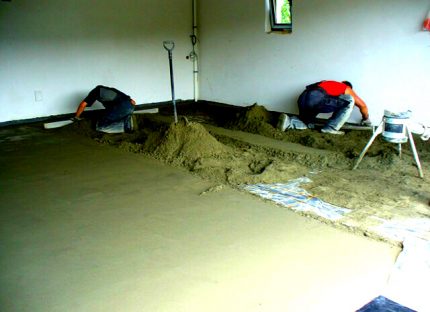
The surface is moistened and the solution between the beacons is laid out on it and aligned with the rule. As it sets, the surface is leveled. At the end, apply a building level to check horizontality. After removing the labels, the resulting voids are poured with a solution and all is left to dry completely.
Infrared film on concrete floor
This version of the heating floor is the most loyal to linoleum, but the thin film is easy to damage, so the concrete base under it should be perfectly smooth. For efficient heat transfer by infrared heaters, this process must occur in one direction.
Any other “warm floor” system functions on the same principle. Unilateral heat transfer is possible only in the case when the thermal conductivity of materials located below and above with respect to the heating elements is radically different.
The heat capacity of the top layer should be significantly higher than that of the subfloor. Subject to these conditions, the efficiency infrared floor can reach 97%. Moreover, the installation of this system does not introduce significant adjustments to the room’s height parameters.

To lay the infrared film on the concrete floor, you must first install the thermal cut-off. After this, work begins, preceding the laying of linoleum.
Features of the shielding layer and its installation
Due to its high reflectivity, a heat shield can reduce heat transfer to a concrete floor by an average of 75%. The best option is a foil coating with a base of lavsan.
There are other cheaper metallized materials made on the basis of foamed polyethylene, but their thermal conductivity is higher, so the heat loss will also be large. A rational approach to this issue involves the acquisition of an electrical and thermal insulation system together with heating elements.
Better when all this is released by one reputable manufacturer. The quality of insulating materials is a guarantee of rational energy consumption for heating. The heat shield is only needed in places where the film is laid, but it is better to lay it over the entire area in order to avoid unevenness.
Installation is carried out in the following sequence:
- Lay out thermal strips on a concrete base, directing the reflecting side up.
- Connect individual strips with double-sided tape.
- They lay a temperature sensor between the tapes and fix it with tape.
- They connect the sensor and the regulator with wires, protecting them with a box or hiding them in strobes made in concrete.
Good quality infrared films and components manufactured by manufacturers such as Q-term, Lavita, Enerpia, Rexva, are noted by many consumers.They have approximately the same technical characteristics, and the difference in cost is a feature of the pricing policy of a particular company.
The choice should be made according to the bandwidth and maximum power. For linoleum, the optimum power is 150 W / m². With this value, the structure of the coating does not change and no harmful substances are released.
Mounting an infrared film
To minimize the number of segments and connection points, stripes are placed along the room. Before laying the film is divided into parts. The length of the cloth depends on its width. For a meter film, let’s cut into segments up to 7 m long, with a width of 0.8 m - 10, and for a half-meter canvas, the maximum length of the thermal strip is 13 m.
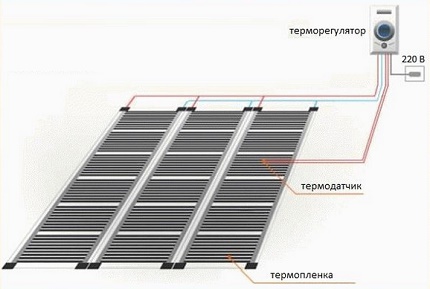
Proper layout - the indent from the walls is 200 mm, the gap between the strips is from 30 to 50 mm, the contacts are as close as possible to the wall on which the thermostat will be placed.
In no case should you allow overlaps. Thermo cloth, using masking tape, is attached to the heat shield. Slices on the sides are also fixed using screws or staples.
At the edges of the copper strip of the film, located in close proximity to the thermostat, put on tips. A power wire will be connected to them. It is inserted into the tip and pressed with pliers. The cuts and connection points of the wires on both sides are insulated with bitumen tape. The bands are connected in parallel.
Upon completion of installation, connect to thermostat and a wire temperature sensor connecting these elements with an infrared film. Check the correctness of the connection, then test the operation of the system on a concrete base.
If everything goes according to plan, the canvas is covered with a plastic film, making an overlap of 20 cm, then the waterproofing is fixed with tape.
Laying linoleum on top of the IR system
This material does not differ in particular rigidity, therefore, in order not to deform the heating elements when walking, a leveling layer is necessary for it. They make it from plywood with moisture resistant properties about 0.8 cm thick.
In order to prevent damage to the film when fixing the plywood sheets, it is necessary that the fasteners fall into the technological gaps provided between the heating elements or at the edges of the film. The mounting pitch is about 150 mm.
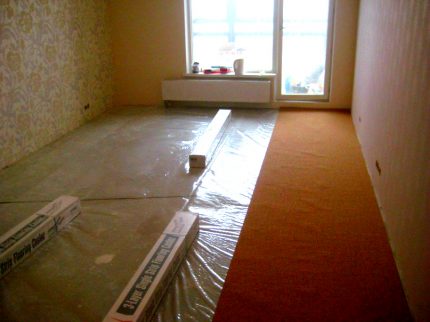
When laying between walls and sheets of plywood, compensating gaps of 0.1 - 0.2 cm should be left. Subsequently, they are filled with a moisture-proof sealant. After the sealant dries, dust is removed from the entire surface with a vacuum cleaner. Further, the plywood is primed, the primer is allowed to dry and the linoleum is laid in the usual way.
Cable electric floor
When laying the cable system, the concrete floor is first leveled, then a reinforcing mesh or a special fixing tape is laid on it. A cable is placed on it, fixed, then poured with concrete mixture. When the screed is dry, lay linoleum.
Before all these work, determine the length of the cable. If it is placed in increments of 15 cm, approximately 25 cm will go into one loop.
With the known area of the room in which the heating floor is to be installed, the number of turns, cable branches and its length as a whole are calculated. To the obtained value is added the segment going from the screed to the wall where the thermostat is located.
When calculating the area covered by the warm floor, the obligatory five-centimeter indent from the walls and the space occupied by the furniture are subtracted from its total value. Thermal insulation is applied to a clean concrete floor over its entire area.Glued joints with foil tape.
In the area reserved for the installation of a warm floor, a metal tape is laid to secure the cable so that it is enough for the entire area. Space is provided on the wall for the regulator. Then make a hole for the installation of the installation box and lay the gates. After mounting the controller, a temperature sensor is attached to it.
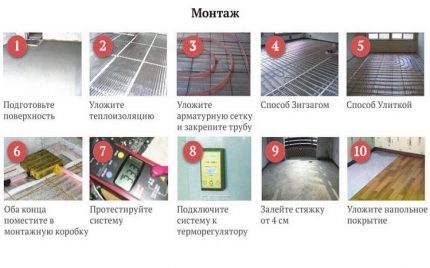
The heating cable is laid starting from the edge of the corrugated tube, on which the cable end sleeve must be present. The electric floor is assembled, adhering to the calculated step in the form of a snake, the branches are laid evenly, excluding creases in turns. The heating cable is fixed with the hooks available on the previously laid metal tape.
Do not pull it tightly, but still the cable should be as straightforward as possible. The step is calculated by multiplying the heated area by 100, followed by dividing the result by the length of the cable.
After a short trial of the system, pour a 5-centimeter layer of screed. When it dries, mount the topcoat.
Water flooring
The water heating system goes well with the concrete base. But here is the final coating of linoleum - not the best choice in this case. Nevertheless, a certain type of linoleum can be laid. The main thing is that it is not thick and low quality.
The scheme should be thought out in advance. A waterproofing layer is laid on a previously prepared base. At the joints between the strips tape strips are glued. Plate heat insulation is placed on top, which is fixed with special fasteners - “fungi”, under which holes are pre-drilled.
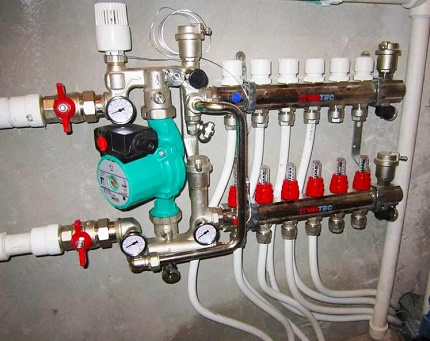
Using the same “fungi”, a reinforcing mesh is attached to the insulation, performing an overlap of the size of one cell and using plastic clamps to connect the individual strips. A collector is installed on the wall, then pipes are connected to it. Compensate for the thermal expansion of the floor by gluing on the walls surrounding it with a special tape.
After this, you can attach the pipes forming the heating circuit to the reinforcing mesh, and then connect them to the collector. A more advanced way of fixing the underfloor heating pipes is to use a mounting system specially designed for this purpose with click clips or guide clips. It is fixed on a concrete base before laying the pipes.
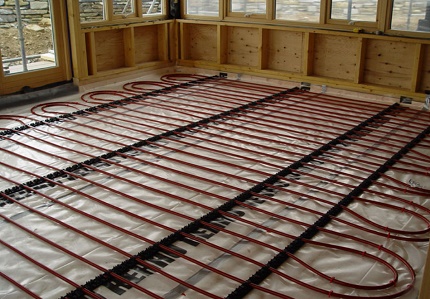
To start pouring screed on the water floor, the pipes need to be filled with water, and beacons installed on the floor and align them with the laser level. A screed with a minimum thickness of 40 mm is poured according to the same rules as when installing other types of underfloor heating.
Floor design with linoleum can be performed no earlier than in a month. During this time, the cement screed will gain the necessary strength. Up to this point, you can not put into operation a water heated floor.
With the technology of building a heating system for linoleum on a wooden base next articlethoroughly analyzing the rules and features of such a system.
Conclusions and useful video on the topic
Video # 1. A visual lesson on the installation of the ideal screed for underfloor heating:
Video # 2. About all the elements of the warm floor in this video:
On the one hand, the technology of installing a warm floor under linoleum on a concrete floor is quite simple.But a good result can only be achieved if all the recommendations are followed. The correct selection of materials, high-quality installation will ensure a long service life of both the system itself and the coating.
Want to talk about how they built a heating system with linoleum laid on top of your house? Do you have useful information on system device technology and flooring? Please leave comments in the block form below, post photos and ask questions about the topic of the article.

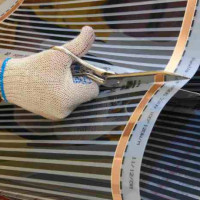 How to make a film underfloor heating under linoleum: instructions for laying an infrared heating system
How to make a film underfloor heating under linoleum: instructions for laying an infrared heating system 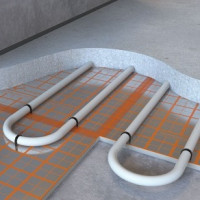 How to make a water heated floor under linoleum: design rules and an overview of installation technology
How to make a water heated floor under linoleum: design rules and an overview of installation technology 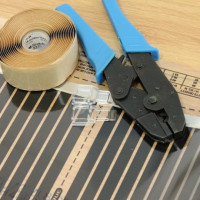 Linoleum electric underfloor heating: system advantages and installation instructions
Linoleum electric underfloor heating: system advantages and installation instructions 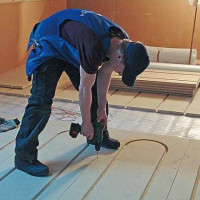 Heated floor under linoleum on a wooden floor: step-by-step installation instruction
Heated floor under linoleum on a wooden floor: step-by-step installation instruction 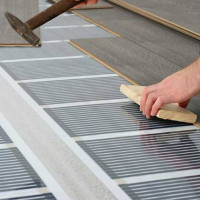 Warm floor under the laminate on the concrete floor: design nuances + detailed installation instruction
Warm floor under the laminate on the concrete floor: design nuances + detailed installation instruction 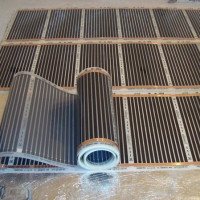 How to make an infrared warm floor with your own hands: installation and connection of a film floor
How to make an infrared warm floor with your own hands: installation and connection of a film floor  How much does it cost to connect gas to a private house: the price of organizing gas supply
How much does it cost to connect gas to a private house: the price of organizing gas supply  The best washing machines with dryer: model rating and customer tips
The best washing machines with dryer: model rating and customer tips  What is the color temperature of light and the nuances of choosing the temperature of the lamps to suit your needs
What is the color temperature of light and the nuances of choosing the temperature of the lamps to suit your needs  Replacement of a geyser in an apartment: replacement paperwork + basic norms and requirements
Replacement of a geyser in an apartment: replacement paperwork + basic norms and requirements
It’s not that I don’t want to see any other material, I just laid linoleum all my life. Somehow already got used to its pluses and minuses, but did not deal with other floor coverings. But there is a great desire to make a warm floor. Our children are small, they constantly play on the floor, and the management company drowns not enough for the Siberian winter, so the floor is often icy. True, if there is a risk of harmful discharge, then you will have to say goodbye to linoleum. I will think.
They say a lot about the discharge, in connection with warm floors, but they forget that in the sun the floor heats up much higher than 30-35 degrees, necessary for the floor to work.
I heard about warm floors before, but when I came closer, I delved into the essence. This is especially true for the floor under linoleum. I would still like to arrange a warm floor in the apartment, but so that a laminate is present as a coating. He impresses me more both in appearance and in practicality. It is more beautiful and more pleasant in contact. Linoleum, however, dries out over time, fades, becomes brittle, and also decreases in size.
So there is a kind of special heat-resistant linoleum. He is not afraid of high temperatures and is quite suitable for any warm floor. He kind of holds a pain of 30 degrees, doesn't he? I don’t know about the amount of harmful emissions, but in theory everything should be buzzing. Well, if you are really afraid of the harmfulness of linoleum, then it’s better to switch to laminate or parquet altogether - expensively and naturally.
I don’t understand why primed plywood before linoleum flooring? And in a previous article it was written that foil coating is not suitable for linoleum under a film floor, but only foamed polyester. This foil article is already suitable. As?